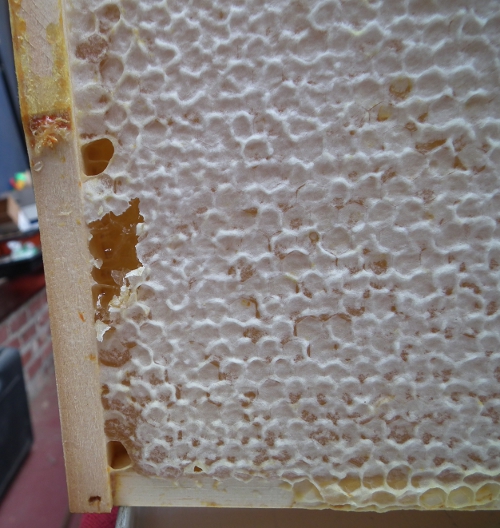I have three hives, with four honey supers, chock-full of honey. But how to extract it? What I did two years ago, just cutting off the capping with a knife and letting it drip, takes a long time during which the hygroscopic honey will absorb a lot of water, making it more prone to fermentation and thus a bad keeper (unless you want mead). Also, I didn’t  look forward to 40  frames drip-dripping in my porch, and then their other sides…
Plenty of other beeks in my bee group - Transition Wayland’s BEElieve  – were in the same boat. We were caught off guard by all that unexpected honey from first-year hives. By the time we started to look for an extractor to all of us buy together, the more economical models were on back order. Beekeeping has taken off  in a big way, and not just in Wayland! Here are two of my bee buddies discussing a brood pattern:
Anyhow, DH and I, being tinkerers, wanted to make our own extractor. When you go on the net you find all sorts of crazy ideas. The guy strapping a cord around the super box and then swinging it around gave me a laugh. Much of our design depended on what we had on the property: two food grade buckets, which previously held wine grapes, and a BBQ rib rack that we could snip and bend to our purposes. We had to buy the stainless steel rod and all the stainless steel hardware (nuts, bolts, screws). Every part that the honey comes in contact with should be either food-grade plastic and/or stainless steel. Ours has a little bit of hardwood involved as well.
As always, it took a few days and versions to get to something practical. Version 1.0, for instance, involved flashing and required three pairs of hands to operate, but we did manage to extract some honey with it. This is version 2.0, the inner contraption and the buckets it sits in, which in turn fit into my big stainless steel canner.
At the moment I’m robbing Hive 3, one of the first-year packages which outperformed the other new colony (which requeened itself) and the three-year-old hive (which swarmed in May) in strength and honey production. Yes, when beeks go in to harvest honey it’s called robbing. The term fits. I pull the frames from the top super, two or four at a time, brushing the bees off with my soft bee brush. They don’t seem to mind, they just fly off or fall down into the hive and go about their business.
Each medium (or so-called Dadant) super frame, when full and capped, weighs about 4 1/2 pounds. First thing to do is take off the cappings without destroying the cell structure of the comb. You can use a hot knife (like in this video), or a cappings scratcher, which reminds me (mother of a seven-year-old) of a giant lice comb.
http://www.youtube.com/watch?v=UuLk6M3g_tk
Strain the honey out of the cappings and keep both. Cappings are made of the most virgin, i.e., purest wax in the hive: ideal for lip balm, etc.
Then we insert the frames into our two-frame extractor and spin it with the electric drill. Once one side is emptied, we flip the frames and go for another round.
http://www.youtube.com/watch?v=0hNwg5I6s4I
This way the honey gets aerated quite a bit, which makes it lighter in color. Over time the air slowly drifts up through the viscous honey and takes whatever wax was also poured in the jar with it, creating a layer of wax on top of the surface – which seals it off. The contrast between the clearer, yellower honey that slowly dripped from the cappings and the spun honey already in the jar is obvious here:
Honeying is very sticky business, and one needs a lot of help cleaning up!
This way we extracted, from eight medium supers, 19 lbs and 4 ounces. Here’s just some of our new stash:
Only 22 more frames to go!









Nice post. It was great fun to be involved in the extraction process! Can’t wait to see mach 10 of the extractor.
Hi, I stumbled on your blog, it is all very interesting and enjoyable. I really like that your children are involved in the processing of honey. We ourselves are in the process of searching for a piece of property that will allow a more self-sufficient lifestyle. And we homeschool, too!
love the new photos on the blog and the cool machines you’ve been making
you’ve been very productive while I’ve been off vacationing and making a big carbon footprint
Thanks for posting the videos! I’m doing a few beekeeping workshops in the next couple months and it helps to have resources and links like these to send to the students so they can refer to after the course. I should probably spend some time making these kind of videos but I think it will take a lot of time. Thanks again